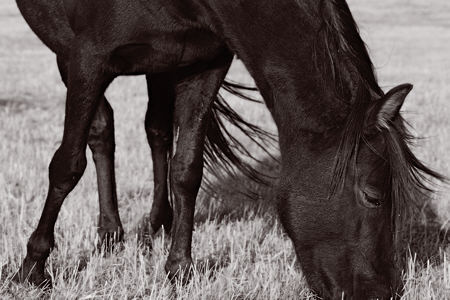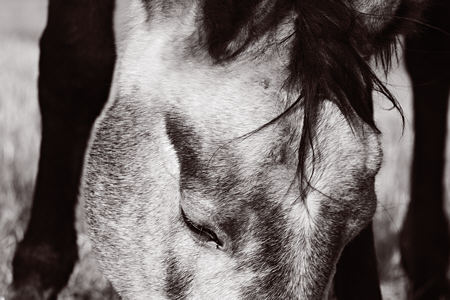
It should be no surprise that in Montana, even in Bozeman, there’s no shortage of artists painting, drawing, sculpting and photographing horses. Which is a delight for me, engaged as I am in such a project myself (posts here and here). That gives me a keen interest in how others have responded to the subject, and enhances my appreciation of their work.
So it’s shocking to me that, before yesterday, I hadn’t thought for a long time about Deborah Butterfield. Two years ago I first saw her horse sculptures at the Yellowstone Art Museum; they had the force of revelation. I remember walking into the room and having to sit down (on a fortunately placed bench) to gaze at the horse there, one of her newer ones in patina’d bronze cast from driftwood. Without any knowledge of Butterfield, her technique, or the subject, my overwhelming impression was that this was a person who understood horses. What they are inside, and how they are put together, in both a physical and a metaphorical way.
Butterfield’s work suffers more than most from being crammed into a web image, of which examples can be seen at gallery web sites (Greg Kucera and Paule Anglim) and several museums, including the Delaware Art Museum with it’s earlier piece in scrap metal. A bit more information is at the Madison (a former stomping ground of my own) Museum of Contemporary Art (site of her first solo exhibition) and Wikipedia, and some history and reviews can be found here.

Butterfield happens to live part time in Bozeman, though I haven’t yet met her. For that reason alone, I feel compelled to deal with her work, to consider what it says to me, and to think of my own work in some relation to that. No, I’m not in any hurry to evaluate and position. Now that I’ve “rediscovered” her horses, I look forward to working in a richer and more stimulating context. I do think we have some similar concerns, for example in how the horse is a creature of parts. She can represent that through the components she selects to assemble in her sculptures; I do it most often by not showing a whole horse, selecting parts in an arrangement I find appealing.
Perhaps the most surprising and intriguing idea that I came across is in my flurry of research in writing this post is Butterfield’s explicit approach to horses as self-portraits. As quoted on the Madison site: “I first used the horse images as a metaphorical substitute for myself–it was a way of doing a self-portrait one step removed from the specificity of Deborah Butterfield.” I suspect this inhabiting of the work may be, in part, what lends it such power.
The notion that an artist’s work represents a portrait of herself, in the general sense that it reflects her character and approach to the world, is a commonplace one. It seems much deeper to me to mentally place oneself in the subject, whether it be a horse, a tree, a mountain, a plum, a house, … I confess I have never thought in quite this way, though a feeling of affinity with the subject is often there. Have you? Or imagined your subject as having some equally intimate, though different connection to yourself? Does that approach have any appeal to you?

Wow, that is an interesting take. The introduction to Butterfield’s work was good and an eye opener included the fact that she chose to identify herself through the choice of her subject – a horse… I wonder if this pointed to something deeper.
Often, artists tend to emblazon their work with ‘states of their mind’ and I was wondering if this was the case in Butterfield’s work… A state of mind rather than a self portrait…
steve:
Are any of the local horse artists named Hugh?
Looked up Deborah Butterfield and very much liked what I saw. Much is made in one site about the lost wax casting that goes into turning her constructs into bronze. This I found distracting as it seems a gallery attempt to play up a non-essential element. There is one piece especially, involving some sign letters that have been incorporated into the horse shape. Feels a little like Picasso’s bicycle bull, but only by association.
I remember having an overwhelmingly positive reaction to a bunch of her horses that are installed on the median strip for several blocks of Park avenue, Manhattan. (you can see a few images at Google Images). I thought about the difference between them and the power mongering horse/rider statues of the Renaissance that occupied city squares. Hers you want to befriend and urge away from the traffic.
Quite a bit of animal art, e.g. that ends up in zoos, parks, or library murals, is a little too obvious or one-off for me. But then there are those artists who get away with it, such as a book I have of Hockney’s dozens of paintings of his two pet dogs. But I think Butterfield is also one who takes it to a much higher level.
For those who are just looking at her work for the first time, I would say don’t judge based on photos–it helps to be in the space and experience the presence.
Jay,
Another of your on-color jokes?
Martha,
Do you mean Manhattan, Montana, just past Belgrade, over by Amsterdam? OK, I just checked Google Images and it appears to be New York City. Butterfield truly is of international caliber. You’re right about the images not doing justice.
Butterfield gets horses right because she represents the curve of how a horse moves–with its head down and its back up–like an upside down “U.” So much horse art is too angular and too fiery/romantic–rearing, high heads etc. But a horse at work, or casually at rest, is not so bombastic visually. I think Steve’s work captures this–the last image on this post is soft and subtle without being romantic.
Yes, though there are a few standouts like Butterfield, and others who are trying to see horses in their own way, a great deal of horse art (and Western art in general) deals in clichés, what others are looking to see and buy. Makes one grateful for the day job.
just browsing the net looking at contemporary art, and found i love the works of Deborah Butterfeild, and find her images and her view of the ‘horse’ very beautiful and simple. her horse sculptures are large and demanding of attention no matter who the person is, and their realtionship with horses.
Her works portray the beauty and power of the horse form successfully, and i enjoy looking at her works.
Alexa Christensen, NZ
Alexa,
What I find really amazing about Butterfield’s work is that the beauty and power you mention come through so strongly despite the seeming awkwardness and perhaps even “ugliness” (to a conventional eye) of the components in the sculptures. My photographs are mostly at the awkward and ugly stage, so I figure it’s a start…